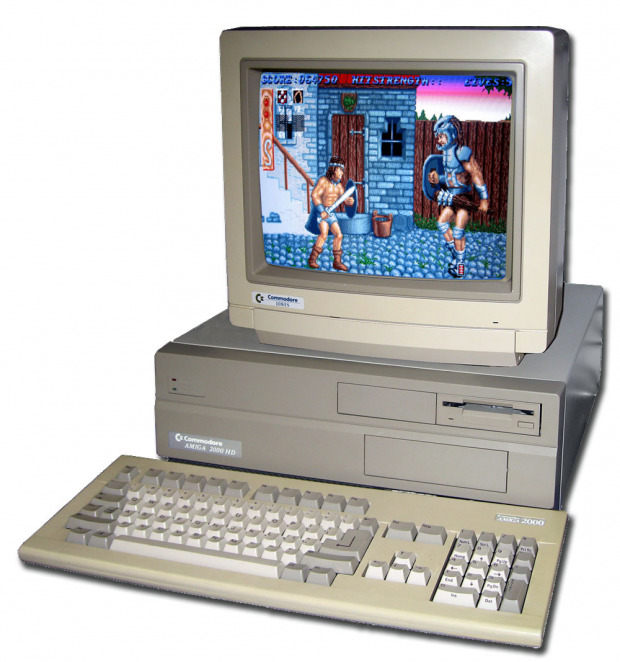Amiga
The Amiga is a family of personal computers sold by Commodore in the 1980s and 1990s. The first model, the A1000, was launched in 1985 and became popular for its graphical, audio and multi-tasking abilities. The Amiga provided a significant upgrade from 8-bit computers, such as the Commodore 64, and the platform quickly grew in popularity among computer enthusiasts. The name "Amiga" was chosen because it is the Spanish word for (female) friend, and alphabetically it appears before Apple in lists of computer makers. It originated as a project called Lorraine, therefore the female was used instead of the male and general version Amigo.
Based on the Motorola 68000 family of microprocessors, the machine has a custom chipset with graphics and sound capabilities that were unprecedented for the price, and a pre-emptive multitasking operating system called AmigaOS. The original operating system, partly based on TRIPOS and written in BCPL, is called AmigaDOS and the GUI is called Workbench. When it was eventually renamed AmigaOS, the BCPL parts were rewritten in the C language.
(Source: Wikipedia)
Works Developed in this Platform:
| Work title | Author | Language | Year |
|---|---|---|---|
| Deadline | Marc Blank | English | 1982 |
| Enchanter | Marc Blank, David Lebling | 1983 | |
| Leather Goddesses of Phobos | Steve Meretzky | 1986 | |
| Nord and Bert Couldn't Make Heads or Tails of It | Jeff O'Neill | English | 1987 |
| Planetfall | Steve Meretzky | 1983 | |
| Portal | Rob Swigart | English | 1986 |
| Sherlock: The Riddle of the Crown Jewels | Bob Bates | 1987 | |
| Speeches | Marek Pampuch | Polish | 1993 |
| Suspended | Michael Berlyn | English | 1983 |
| The Witness | Stu Galley | 1983 | |
| Trinity | Brian Moriarty | 1986 | |
| Wishbringer: The Magick Stone of Dreams | Brian Moriarty | 1985 |
Development of the Amiga began in 1982 with Jay Miner, developer of the Atari 800 chip set, as the principal hardware designer of Amiga Corporation. It was initially intended to be a next generation video game machine, but was redesigned as a general purpose computer after the North American video game crash of 1983.[4][5] A prototype of the full computer was shown to the public for the first time at the Summer Consumer Electronics Show in 1984.[6] In order to bring the design to market Commodore International bought Amiga Corporation and funded development. The first model was released in 1985 as simply "The Amiga from Commodore", later to be retroactively dubbed the Amiga 1000. The following year the Amiga product line was expanded with the introduction of two new models: the Amiga 2000 for high-end graphics and business use, and the Amiga 500 for home use. Commodore later released other Amiga models, both for low-end gaming use and high-end productivity use.
In 1994, Commodore filed for bankruptcy and its assets were purchased by Escom, a German PC manufacturer, who created the subsidiary company Amiga Technologies. They re-released the A1200 and A4000T, and introduced a new 68060 version of the A4000T. However, Escom in turn went bankrupt in 1997. The Amiga brand was then sold to another PC manufacturer, Gateway 2000, which had announced grand plans for it. However, in 2000, Gateway sold the Amiga brand without having released any products. The current owner of the trademark, Amiga, Inc, licensed the rights to sell hardware using the Amiga or AmigaOne brand to computer vendors Commodore USA, Eyetech Group, Ltd. and A-Eon Technology CVBA. Unofficial AmigaOne clones were developed by Italian hardware company, Acube.
(Source: Wikipedia)



